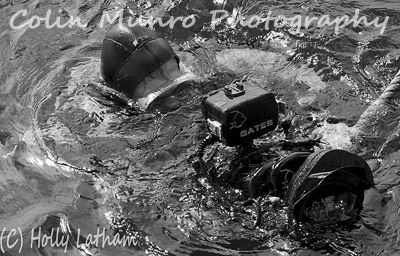“I turned around and saw him about one hundred rods directly ahead of us, coming down with twice his ordinary speed of around 24 knots, and it appeared with tenfold fury and vengeance in his aspect. The surf flew in all directions about him with the continual violent thrashing of his tail. His head about half out of the water, and in that way he came upon us, and again struck the ship.” So wrote Owen Chase, First Mate, in his 1821 account of the sinking of the whaling ship the Essex.

A sperm whale raises its tail flukes as it begins a dive.
The whale in question was a cachalot, or sperm whale. Probably the best known whale; the whale in Herman Melville’s Moby Dick (which was actually based on the sinking of the Essex). The sperm whale, Physeter macrocephalus, is the largest toothed whale, and indeed the largest toothed predator that has ever lived. Males average 16 metres in length and over 40 tonnes in weight (females are significantly smaller); some may exceed 20 metres and 50 tonnes. They are the sole extant (living) species in the family Physeteridae, though fossils of several extinct species have been found. Sperm whales look like no other whale; their massive head and relatively tiny lower jaw coupled with their huge size renders them unmistakable when seen underwater. However that is not how they are commonly seen. The best view most of us get of a sperm whale is of them resting almost motionless on the surface, between dives, with only the top of their back and their blowhole visible, followed by the rise of the tail flukes as it descends beneath the surface.

The blow hole and wrinkled skin of a sperm whale resting on the surface
As sperm whales are air breathing mammals it is tempting to think of them as animals that live at the surface, diving occasionally to hunt. Not so. When feeding they will spend 8-10 minutes on the surface breathing, replenishing their oxygen supplies. In contrast they will spend 35-50 minutes underwater searching for prey.

The low, bushy, forward-directed, blow of a sperm whale is almost unmistakable
Studies indicate that sperm whales will spend 70-95% of their time in these foraging cycles so, in terms of where they spend most of their time, these are creatures that inhabit the ocean depths and surface only briefly to breathe.
Unlike most other great whales, the sperm whale does not venture into polar waters to feed, preferring tropical and temperate seas (adult males will venture in to high latitudes). But even in the tropics it inhabits a cold world. At a thousand metres depth, well within the normal foraging range of sperm whales, the temperature is only 4-8 degrees centigrade. It is also a world of almost total darkness. At 200 metres depth, even in the open ocean the light levels are less than 1/1000th of those at the surface. At a thousand metres one enters the aphotic zone (the midnight zone) where no sunlight penetrates. But that does not mean it is a world devoid of light. It is a world full of bioluminescence. Light produced by chemical reactions within living organisms. It has been estimated that that 90% of the animals that live below 1000 metres are capable of bioluminecence; glowing, flashing or pulsing green, red, but or white. This includes many of the prey species of sperm whales. Although they do also consume fish, cephalopods (octopus, cuttlefish and squid) are by far the greatest portion of their diet. Famously they predate on giant squid and the even larger colossal squid (which may be longer than a full grown sperm whale and is the largest known invertebrate) but they also consume a wide variety of other cephalopod species. This includes the wonderfully named vampire squid (Vampyroteuthis infernalis is its scientific name, which translates as ‘vampire squid from hell). Neither a vampire nor a squid it occupies a cephalopod Order all of its own, the Vampyromorphida.
There are a few spots in the oceans renowned for sperm whale sightings. These are mostly along the edges of underwater canyons and steep drop-offs, where shallow coastal seabeds plunge sharply to hundreds or thousands of metres. Off the Kaikoura peninsula of New Zealand is possibly the best known area, followed by the Azores islands (where volcanic seamounts rise up from deep water). The images of mine in this blog were all take off Vesteralen, northern Norway, where a complex of deep canyons direct the seabed offshore from the Lofoten Islands and Vesteralen archipelago. It appears sperm whales hunt along these canyons, thus time spent cruising along the margins of the canyons is often rewarded by sightings of sperm whales as these surface between foraging dives to expel carbon dioxide and replenish their oxygen supplies.
